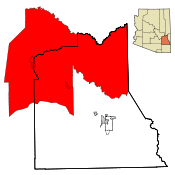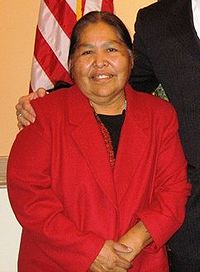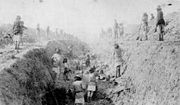
San Carlos Apache Indian Reservation
Encyclopedia

Arizona
Arizona ; is a state located in the southwestern region of the United States. It is also part of the western United States and the mountain west. The capital and largest city is Phoenix...
, United States
United States
The United States of America is a federal constitutional republic comprising fifty states and a federal district...
, was established in 1871 as a reservation for the Chiricahua Apache tribe. It was referred to by some as "Hell's Forty Acres," due to a myriad of dismal health and environmental conditions.
Formation
President U.S. GrantUlysses S. Grant
Ulysses S. Grant was the 18th President of the United States as well as military commander during the Civil War and post-war Reconstruction periods. Under Grant's command, the Union Army defeated the Confederate military and ended the Confederate States of America...
established the San Carlos Apache Reservation on December 14, 1872. The government gave various religious groups the responsibility for managing the new reservations, and the Dutch Reformed Church
Dutch Reformed Church
The Dutch Reformed Church was a Reformed Christian denomination in the Netherlands. It existed from the 1570s to 2004, the year it merged with the Reformed Churches in the Netherlands and the Evangelical Lutheran Church in the Kingdom of the Netherlands to form the Protestant Church in the...
was given charge of the San Carlos Apache Indian Reservation. They sought out a candidate to run the reservation at Rutgers College
Rutgers University
Rutgers, The State University of New Jersey , is the largest institution for higher education in New Jersey, United States. It was originally chartered as Queen's College in 1766. It is the eighth-oldest college in the United States and one of the nine Colonial colleges founded before the American...
and were connected with John Clum
John Clum
John Philip Clum was an Indian agent for the San Carlos Apache Indian Reservation in the Arizona Territory. He implemented a limited form of self-government on the reservation that was so successful that other reservations were closed and their residents moved to San Carlos. Clum later became the...
, who had attended the church while in school in Claverack, New York
Claverack, New York
Claverack is a town in Columbia County, New York, United States. The population was 6,401 at the 2000 census. The town name is a corruption for the Dutch word for "Clover Fields" or "Clover Reach"....
. Clum knew that a number of Indian Agents sought the position only as a means to line their own pocket, selling government-supplied food and clothing and keeping the profits for themselves.
The Apaches, who were supposed to be fed and housed by their caretakers, rarely saw the results of the federal money and suffered as a result. The U.S. Army showed both animosity toward the Indians and disdain for the civilian Indian Agents. Soldiers and their commanding officers sometimes brutally tortured or killed the Indians them for sport. After turning the position down twice, Clum relented and on February 16, 1874, Clum accepted a commission as Indian Agent for the San Carlos Apache Indian Reservation in the Arizona Territory
Arizona Territory
The Territory of Arizona was an organized incorporated territory of the United States that existed from February 24, 1863 until February 14, 1912, when it was admitted to the Union as the 48th state....
.
To the distant politicians in Washington, D.C., all Indians were alike. They did not give consideration to the different tribes, cultures, customs and language. They also ignored prior political differences and military alliances. They tried to apply a “one-size-fits-all" strategy to deal with the “Indian problem”. As a result, friends and foes alike were forced to live in close proximity to one another.
Clum arrived at the reservation on August 4, 1874. During his tenure at San Carlos, he struck a lifelong friendship with Eskiminzin
Eskiminzin
Eskiminzin was an Aravaipa Apache chief during the Apache Wars....
, an Aravaipa Apache chief, and persuaded many of the White Mountain people to move south to San Carlos. He visited Apache camps without soldiers and fiercely defended the Apaches against the military's interferance. In this way Clum gradually and grudgingly won the Indians's confidence. They responded by turning in their weapons, using a tribal court to try minor infractions, and joining the Tribal Police
San Carlos Apache Police Department
The San Carlos Apache Police Department is the tribal police agency responsible for law enforcement within the jurisdiction of the San Carlos Apache Indian Reservation...
organized under Clum's command, forming a system of limited Indian self-rule. The agent soon attracted 4,200 Apaches and Yavaais Indians to the semi-arid reservation. The Army bristled at Clum's actions because they prevented them from raking off part of the funds that passed through the reservation.
On April 21, 1877 Clum along with 100 of his best Apache Police captured the marauding Geronimo
Geronimo
Geronimo was a prominent Native American leader of the Chiricahua Apache who fought against Mexico and the United States for their expansion into Apache tribal lands for several decades during the Apache Wars. Allegedly, "Geronimo" was the name given to him during a Mexican incident...
at the Ojo Caliente Reservation in the New Mexico Territory
New Mexico Territory
thumb|right|240px|Proposed boundaries for State of New Mexico, 1850The Territory of New Mexico was an organized incorporated territory of the United States that existed from September 9, 1850, until January 6, 1912, when the final extent of the territory was admitted to the Union as the State of...
. The U.S. Army, which had mounted intense efforts to track-down and capture Geronimo, was seriously embarrassed by his success and their failure. Indian Bureau administrators and U.S. Army commanders disliked his methods and continually frustrated his efforts. He finally resigned. The reservation's new administrators released Geronimo, resulting in more than 15 years of conflict across the American southwest.
Tribes consolidated
After the Chiricahuan Apache were deported east to Florida in 1886, San Carlos became the reservation for various other relocated Apachean-speaking groups. These included the Pinal Coyotero of the northern Gila RiverGila River
The Gila River is a tributary of the Colorado River, 650 miles long, in the southwestern states of New Mexico and Arizona.-Description:...
area, the Mimbreños, Aravaipa, Pinaleño, Tonto, Tsiltaden, and the Lipan. After the Indian Reorganization Act
Indian Reorganization Act
The Indian Reorganization Act of June 18, 1934 the Indian New Deal, was U.S. federal legislation that secured certain rights to Native Americans, including Alaska Natives...
of 1934, they formed a government together and became federally recognized as the San Carlos Nation. Grenville Goodwin
Greenville Goodwin
Grenville Goodwin, born Greenville Goodwin , is best known for his participant-observer ethnology work among the Western Apache in the 1930s in the American Southwest. Largely self-taught as an anthropologist, he lived among the Apache for nearly a decade, and learned their stories and rituals...
, an anthropologist who had lived with the Western Apache since the late 1920s, helped them to decide what government they wanted to form under the new law to gain back more sovereignty.
Population
The 2000 censusUnited States Census, 2000
The Twenty-second United States Census, known as Census 2000 and conducted by the Census Bureau, determined the resident population of the United States on April 1, 2000, to be 281,421,906, an increase of 13.2% over the 248,709,873 persons enumerated during the 1990 Census...
reported the reservation population at 9,385. Its largest communities are San Carlos
San Carlos, Arizona
San Carlos is a census-designated place in Gila County, Arizona, United States. The population was 3,716 at the 2000 census.San Carlos is the largest community in and the seat of government for the San Carlos Apache Indian Reservation....
and adjacent Peridot
Peridot, Arizona
Peridot is a census-designated place in Gila and Graham counties in the U.S. state of Arizona. The population was 1,266 at the 2000 census.Peridot is named for the mineral peridot, found in basalt flows nearby.-Geography:...
.
The San Carlos Reservation is one of the poorest Native American communities in the United States
United States
The United States of America is a federal constitutional republic comprising fifty states and a federal district...
, with an annual median household income of approximately $14,000 in 2000, according to the US Census. About 60% of the people live under the poverty line, and one-fourth of the active labor force is unemployed.
Geography
Encompassing 2,910.7 square miles (7,538.7 km²) of land area, the San Carlos Apache Indian Reservation lies in northern GrahamGraham County, Arizona
-2010:Whereas according to the 2010 U.S. Census Bureau:*72.1% White*1.8% Black*14.4% Native American*0.5% Asian*0.1% Native Hawaiian or Pacific Islander*2.8% Two or more races*8.3% Other races*30.4% Hispanic or Latino -2000:...
, southeastern Gila
Gila County, Arizona
-2010:Whereas according to the 2010 U.S. Census Bureau:*76.8% White*0.4% Black*14.8% Native American*0.5% Asian*0.1% Native Hawaiian or Pacific Islander*2.0% Two or more races*5.4% Other races*17.9% Hispanic or Latino -2000:...
, and eastern Pinal
Pinal County, Arizona
-2010:Whereas according to the 2010 U.S. Census Bureau:*72.4% White*4.6% Black*5.6% Native American*1.7% Asian*0.4% Native Hawaiian or Pacific Islander*3.8% Two or more races*11.5% Other races*28.5% Hispanic or Latino -2000:...
Counties. It is the tenth-largest Indian reservation in land area. Landscape of the area varies considerably, including desert, alpine meadows, and Ponderosa Pine
Ponderosa Pine
Pinus ponderosa, commonly known as the Ponderosa Pine, Bull Pine, Blackjack Pine, or Western Yellow Pine, is a widespread and variable pine native to western North America. It was first described by David Douglas in 1826, from eastern Washington near present-day Spokane...
forest. Its largest community is San Carlos
San Carlos, Arizona
San Carlos is a census-designated place in Gila County, Arizona, United States. The population was 3,716 at the 2000 census.San Carlos is the largest community in and the seat of government for the San Carlos Apache Indian Reservation....
. The Fort Apache Indian Reservation
Fort Apache Indian Reservation
The Fort Apache Indian Reservation is an Indian reservation in Arizona, United States, encompassing parts of Navajo, Gila, and Apache counties. It is home to the federally recognized White Mountain Apache Tribe of the Fort Apache Reservation, a Western Apache tribe. It has a land area of 2,627.608...
, which has a smaller land area but a population of more than 12,000, is directly north of the San Carlos Reservation.



Attractions
- The Apache Gold casino, owned and operated by the San Carlos Apache Nation, offers gaming, dining and lodging.
- The San Carlos Apache Culture Center tells the stories and history of the Apache people.
- Hunting, fishing, boating, camping, birdwatching and nature study are all popular on the scenic 2900 square miles (7,511 km²) reservation. All of these activities require a tribal permit, available from the San Carlos Recreation and Wildlife department, and at local convenience and sporting-goods stores.
External links
- San Carlos Apache Nation, official website
- San Carlos community profile, from Arizona Department of Commerce
- San Carlos Lake
- San Carlos Apache people, East Central Arizona History
- Apache Times, Web Portal San Carlos Apache Community

